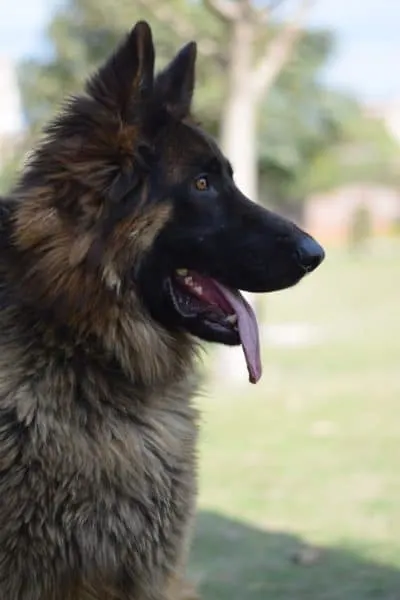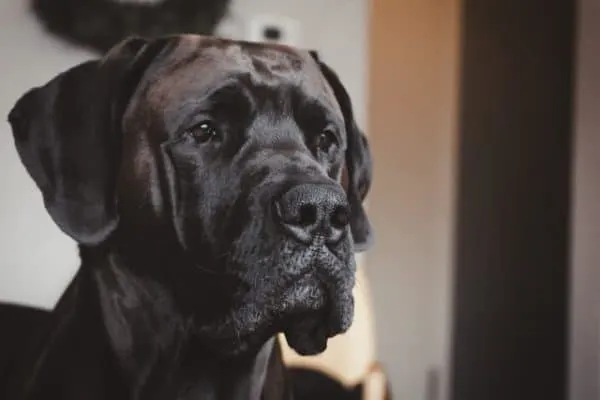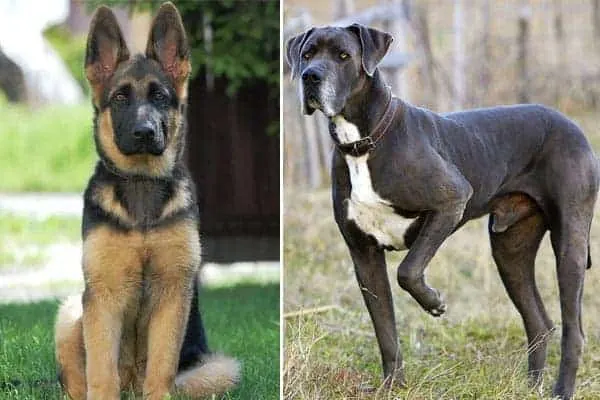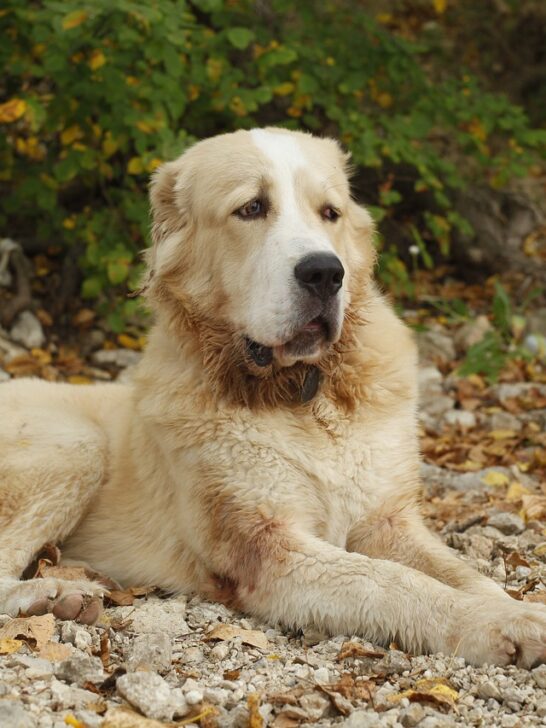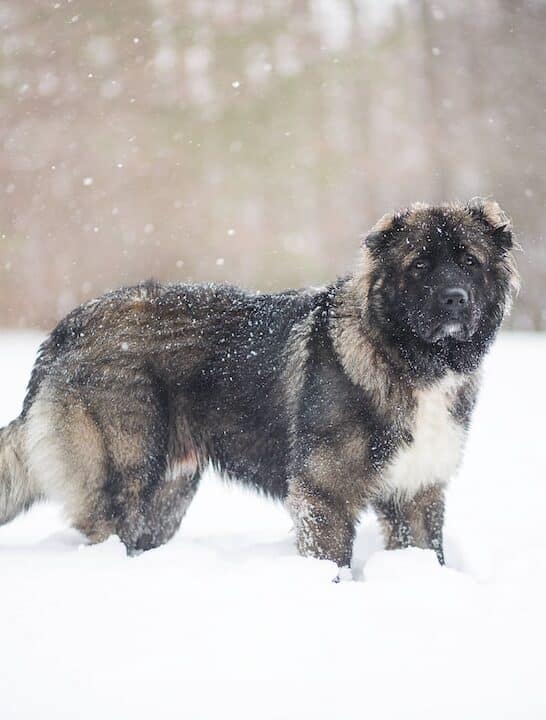German Shepherds vs. Great Danes: 14 Major Differences
Although there are many differences between German Shepherd Dogs (or GSDs) and Great Danes, they do possess many similarities.
Both breeds are prone to health problems like bloat. Both breeds love people, are easier to train than many other breeds, and make great pets.
All dog breeds share over 99 percent of their DNA. Even though it is less than one percent, those slight differences in genes make a huge difference in doggy bodies.
In order to do an extensive German Shepherd vs Great Dane breed comparison, we have put a list together of 14 major differences between the two dogs.
Let’s get started!
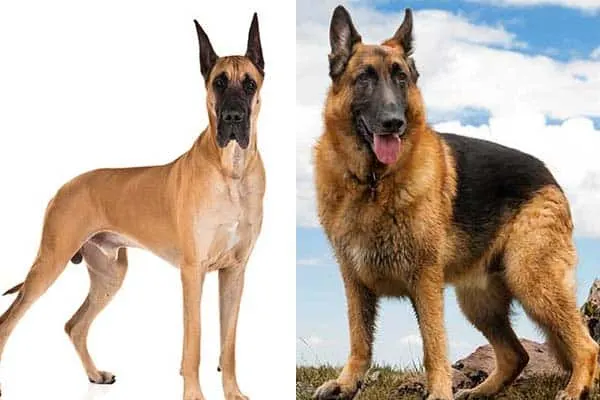
One: Differences in Size
The most striking differences are in the height and weight of these two dog breeds. Great Danes grow anywhere from 28 to 34 inches high at the tops of their shoulders (or withers.)
They crush the scales from 99 to 200 pounds.
GSDs grow to be big dogs, but nowhere near as big or as heavy as a Great Dane. They measure from 22 inches high to two feet, two inches high.
They weigh from a small female at 49 pounds to a large male at 88 pounds.
Two: Differences in Ear Shape
Another striking difference in these two dog breeds is their ear shape. GSDs sport triangular, wolf-like ears. Great Danes sport floppy ears.
All puppies are born with floppy ears but after a few months, the ears of GSD puppies begin lifting.
Maybe you’ve seen Great Danes at dog shows on TV with triangular ears.
They weren’t born that way. Those dogs’ ears were cropped or cut not for health reasons, but for cosmetic reasons.
Ear cropping is banned in many countries, but not in America.
Three: Differences in Ear Problems
Because of the floppy ear shape of dogs with uncropped ears, Great Danes may suffer more ear infections than GSDs.
Floppy ears get in food and keep the inside of the ears wetter than foxy ears. Air circulates better in GSD ears than in Great Danes with natural ears.
This does not mean that cropping ears are the best solution. Great Dane owners gently turn the floppy ears inside-out so they can dry out naturally.
After every meal, any dirty ears are wiped clean.
Four: Great Danes are an Official State Dog
The Great Dane boasts a title that GSDs can’t. Since August 17, 1965, they have been the official state dog of Pennsylvania.
In contrast, the GSD is not the official dog of anything, except for their owners’ hearts.
How did a Dutch dog breed wind up as the official dog breed of an American commonwealth?
When William Penn, the state’s founder, came to America, he and his friends brought over their beloved Great Danes.
Five: Differences in Life Expectancy
It’s a general rule that the larger the dog, the shorter the lifespan. According to the American Kennel Club (AKC), the average life expectancy of a German shepherd is seven to ten years.
Officially, the life expectancy of a Great Dane is the same, but they usually die by age eight.
Why is this? According to Smithsonian Magazine, the internal organs of big, heavy dogs need to do more work than for smaller and lighter dogs and so age faster.
Just why this happens to dogs and not other animal species is still a mystery.
Six: Differences in Getting Degenerative Myelopathy
Degenerative myelopathy or DE is a terrible disease of the spinal cord. Its cause is unknown but may be hereditary.
According to the Mid-Atlantic German Shepherd Dog Rescue, only GDS or dogs with a lot of GSD in them suffer from DE.
DE mostly impacts dogs over seven years old, like Niki in this YouTube video. It’s similar to multiple sclerosis in people in that it causes loss of coordination.
It always gets worse over time and there is no cure.
Seven: Differences in Color
Great Danes appear in many solid colors like black, fawn (a kind of tan), and blue (a blueish-grey.) They also come in many patterns, like loud spots to tan, black and white striping called brindle.
When it comes to coat color, Great Danes possess a larger rainbow than GSDs. They only appear in all black, all liver (a dark brown), black and tan, black and silver and black and red.
They also appear in white, but these are not allowed to be shown.
Eight: Differences in Drooling
Another major difference in the two breeds is the amount they drool in the course of a normal day.
A healthy Great Dane is a champion drooler because of the large flaps and folds of the muzzle help the dog smell better by keeping the nose skin moist with saliva.
In contrast, German Shepherds have mostly smooth skin over their muzzles. A GSD only drools when hungry or sick.
If your GSD starts drooling all day for seemingly no reason, it’s time to call the vet.
Nine: Differences in Public Perception
People unfairly judge how a dog will act based only on appearance, just as they still do for people. In this case, German Shepherds get the worst of it.
They are perceived as vicious, while Great Danes are perceived as friendly.
This has led to GSDs being banned in some places. According to Pethelpful, GSDs are banned in eleven countries, including the Ukraine, Belarus, and the Maldives.
Before bringing a GSD home, check out your local dog or pet laws to see if it’s legal to own one.
Ten: Differences in Popularity
Ironically, GSDs are far more popular around the world than Great Danes.
In the United States, for example, GSDs rank in the American Kennel Club as the second most popular dog breed, while Great Danes are only in sixteenth place.
GSDs are also very popular in the Middle East, France, Germany, Belgium, Great Britain, and Russia.
Great Danes will probably never be as popular as GSDs because of their great size, shorter lives, and proclivity for short lives.
Eleven: Differences in Coat Length
Great Danes are covered in a fine, silky-short hair. This makes them easier to groom than a GSD but also makes them more prone to shedding.
A dog that sheds a lot can make someone allergic to dogs very sick, indeed.
GSD coats vary in length from dog to dog, but mostly they are of medium length. They have thick double coats to help protect them from bad weather.
The top coat, called guard hairs, are harsher than the soft, dense undercoat.
Twelve: Differences in Use by People
Great Danes are unfairly thought of harder to train than GSDs because you never see a Great Dane leading a blind person or working with the police.
Great Danes learn just as well as GSDs and train just as quickly.
The problem with Great Danes is that they do not live as long and are harder to transport to places because of their size.
It’s not worth all of the time and effort to train a guide dog, for example, if the dog winds up dying in only a few years.
Thirteen: Differences in Vocalizations
Because of their great size, Great Danes possess a much deeper bark and growl than a German Shepherd dog’s. Exceptions exist, but for the most part, GSDs are more vocal because they were bred to be that way.
GSDs often get jobs like working with the police, herding livestock, or guarding property.
These jobs require dogs to bark in order to warn people away or bring people to where they are, depending on the job that needs doing. As a consequence, GSDs are trained to bark.
Fourteen: Differences in Energy Levels
Despite looking like a racehorse with a dog’s head, Great Danes need a comparatively little exercise to many other dog breeds, including the German shepherd.
This is because they were bred to mostly stay in one place as a guard dog.
GSDs were bred to run about all day over all kinds of terrain in order to protect sheep or other livestock.
This means that if you want to bring a GSD home, get ready to exercise every day in order to keep your new dog from bouncing off of the walls. ‘
In Summary: Both Great Danes and German Shepherds Make Great Dogs
German Shepherd dogs and Great Danes are both terrific dog breeds that begin with the letter G.
On the whole, Great Danes are larger, heavier, and live shorter lives than GSDs. Both dogs of either breed make great companions.
Before bringing any dog home, make sure you are allowed to keep a dog if you do not own where you live.
You also need to spend a lot of time and money keeping your dog healthy and happy.
Related Post: Can a Big German Shepherd Great Dane Mix Be the Best Thing For Your Family?














